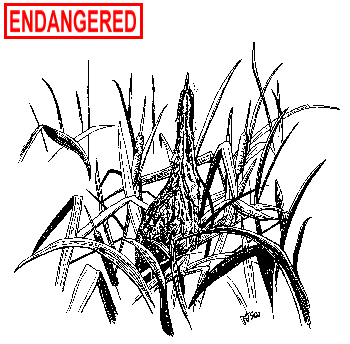American Bittern
Botaurus lentiginosus

Habitat: Freshwater and saltwater wetlands.
Weight: 1-2 pounds.
Length: 28 inches.
Wingspan: 42 inches.
Life Expectancy: Approximately 8 years of age.
Food: Frogs, salamanders, crayfish, water scorpions, diving beetles, dragonflies, killifish, pickerel, suckers, small eels, garter and water snakes, and occasionally voles.
Status: State endangered.
Identification: Adult American bitterns are large, somewhat stocky birds with yellow eyes, rich brown upperparts, and a white throat that is offset by black streaks. Dark flight feathers are conspicuous on the wing tips when the birds are in flight. The sexes are similar in appearance. Juvenile bitterns lack neck streaking.
Range: American bitterns occur from Central British Columbia east to Newfoundland, south, locally, to the Gulf Coast and west to southern California. They migrate south, but not to the extent that many other wetland birds do. The species winters in the southeastern and Gulf States and as far south as Central America and Cuba.
Reproduction: American bitterns migrate north to breed from mid-April to early May. Unlike other members of the heron family, these birds are not colonial nesters. Male bitterns may be polygamous (more than 1 mate) and often have several females nesting separately within their territory. Females choose the nest site in wetland areas, usually on the ground or raised slightly on a platform of thick vegetation. The female also builds the nest, usually out of reeds, sedges and similar plant material. The nest is 6 to 13 inches high and 12 to 16 inches wide, The 2 to 5 elliptical, olive-buff to buff-brown, slightly glossy eggs are laid at daily intervals.
Incubation begins when the first egg is laid and lasts for 24 to 29 days. The female is responsible for both incubation and tending the young. Young bitterns differ in size. They leave the nest after about two weeks but continue to be tended nearby. Their age of independence and first flight is unknown.
Reason for Decline: The primary reason for the decline in American bittern populations is loss of habitat. The marshes and swamps upon which this species depends have been drained and filled for a variety of human uses including roadways, housing and commercial developments.
History in Connecticut: The American bittern was common in Connecticut during the late 1800s and it was a regular, but not abundant, resident of freshwater wetlands in the early 1900s. It is currently considered a rare migrant and uncommon nester, with only one confirmed Connecticut breeding location reported in the last decade.
Interesting Facts: The American bittern, like many other herons, is solitary and moves slowly and secretively through dense marsh vegetation. Bitterns are most active at dusk and through the night. If alarmed, a bittern will stand motionless with its bill pointed straight up and its body contracted. This habit gave the bird its regional names of sky-gazer, look-up and stake-bird. Bitterns that flush when startled give a nasal "haink" call and beat their wings rapidly as they take flight.
Bitterns call most often in the spring. A loud, guttural "pump-er-wink" is usually heard at dusk and gets its booming quality from a specialized esophagus. This unique call has led to many other common names, including water-belcher, mire drum and thunder pumper.
During the breeding season, the males perform a remarkable courtship walk displaying white fan-like ruffs raised over their back and shoulders.
Protective Legislation: Federal - Migratory Bird Treaty Act of 1918. State - Connecticut General Statutes Sec. 26-311.
What You Can Do: Support for strong wetland conservation legislation, along with water pollution control efforts, will help protect the habitat of American bitterns.

The production of this Endangered and Threatened Species Fact Sheet Series is made possible by donations to the Endangered Species-Wildlife Income Tax Checkoff Fund. (rev. 12/99)

